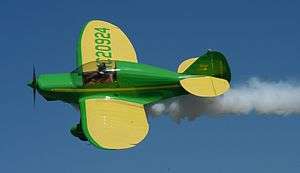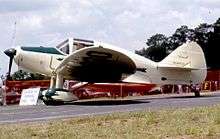Culver Dart
The Culver Dart was a 1930s American two-seat light monoplane aircraft produced by the Dart Aircraft Company (later the Culver Aircraft Company).
| Dart | |
|---|---|
 | |
| A restored 1939 Culver Dart GK equipped for aerobatics over PLK | |
| Role | Two-seat Light Monoplane |
| Manufacturer | Culver Aircraft Company |
| Designer | Albert Mooney |
Design and development
In the early 1930s Al Mooney was working for the Lambert Aircraft Corporation, builders of the Monocoupe series aircraft. He designed a small two-seat monoplane, the Monosport G.[1] When the company ran into financial difficulties Mooney bought the rights to his design and with K.K. Culver formed the Dart Aircraft Company.[2] The aircraft was renamed the Dart Dart or Dart Model G.[3]
The aircraft was a low-wing monoplane designed to be light with clean lines to enable it to use low powered aero-engines. It had a fixed undercarriage and a tailwheel. The initial version was named the Dart G powered by a 90 hp (67 kW) Lambert R-266 radial engine. That engine was in short supply, so the aircraft was fitted with a Ken-Royce engine and designated the Dart GK. The final version was the Dart GW powered by a Warner Scarab Junior radial engine. Two special aircraft were built with larger engines. In 1939 the company was renamed the Culver Aircraft Company and the aircraft was renamed the Culver Dart.
Variants
.jpg)

- Dart G
- Initial production version powered by a 90 hp (67 kW) Lambert R-266 - ca. 50 built.
- Dart GC
- 125 hp (93 kW) Continental O-200 - 10 built
- Dart GK
- Variant fitted with a 90 hp (67 kW) Ken-Royce 5G engine - 25 built.
- Dart GW
- Final production version powered by a 90 hp (67 kW) Warner Scarab Junior - 8 built.
- Dart GW Special
- Two aircraft fitted with larger Warner engines, one with a 125 hp (93 kW) Warner Scarab engine, and the other with 145 hp (108 kW) Warner Super Scarab SS-50A engine.
- X-F 220 Super Dart
- An experimental variant modified with a 220 hp (160 kW) Continental R-670, 8 foot wing reduction and a 188 mph (163 kn; 303 km/h) cruise speed. Used by Rodney Jocelyn in national aerobatics.[4]
Surviving aircraft
The Ohio History Connection holds a Culver Dart G, NC18449, in its permanent collection since 2000. The airplane currently resides in offsite storage.
Specifications (Dart GW)
Data from Simpson, 2001, p.170
General characteristics
- Crew: 2
- Length: ()
- Wingspan: 29 ft 6 in (8.99 m)
- Height: 6 ft 1 in (1.85 m)
- Wing area: 176 ft² (16.35 m²)
- Empty weight: 940 lb (426 kg)
- Max. takeoff weight: 1,540 lb (699 kg)
- Powerplant: 1 × Warner Scarab Junior 5-cyl. air-cooled radial piston engine, 90 hp (67 kw)
Performance
- Maximum speed: 131 mph (211 km/h)
- Range: 495 miles (797 km)
- Service ceiling: 16,000 ft (4875 m)
See also
References
- Notes
- "Culver Dart GC". www.flightmuseum.com. Frontiers of Flight Museum. Retrieved 24 October 2018.
- "Al Mooney Papers: Biographical Sketch". libtreasures.utdallas.edu. Eugene McDermott Library, University of Texas. Retrieved 24 October 2018.
- Simpson, 2001, p. 170.
- "220 horse "Super Dart"". experimenter: 4. January 1955.
- Bibliography
- Baxter, Gordon. The Al Mooney Story. They All Fly Through The Same Air. Fredricksburg, Texas: Shearer Publishing, 1985. ISBN 978-0940672345
- The Illustrated Encyclopedia of Aircraft (Part Work 1982-1985). London: Orbis Publishing, 1985.
- Sargent, S.B., "Dashing and Darting Through the Sky: The diminutive Culver Dart Model LCA," Vintage Airplane, April 2007. retrieved 24 October 2018.
- Simpson, R.W. Airlife's General Aviation. Shrewsbury, UK: Airlife, 1991. ISBN 1-85310-194-X.
- Simpson, Rod. Airlife's World Aircraft. Shrewsbury, UK: Airlife Publishing Ltd, 2001. ISBN 1-84037-115-3.
External links
| Wikimedia Commons has media related to Dart G. |
- Al Mooney designs
- Guide to the Al Mooney Papers, 1904-1986, Eugene McDermott Library, University of Texas, retrieved 24 October 2018.